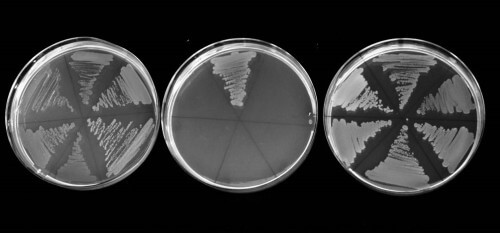Many bacteria carry a kind of "poison pill" for the purpose of suicide, and next to it a substance that counteracts the toxin - which protects it from poisoning. A new study by Weizmann Institute of Science scientists discovers several unique forms of such bacterial "poison pills", and explains how they help bacteria defend themselves against virus attack.

Bacteria may be efficient factories for the production of toxins of various types. In addition to those harmful to humans, such as the tetanus and botulinum toxins, or those used by them to fight other types of bacteria, today it is also known that the bacteria produce unique toxins, which are used to kill the bacteria itself. In fact, many bacteria carry a kind of "poison pill" for the purpose of suicide, and next to it a substance that counteracts the toxin - which protects it from poisoning. A new study by Weizmann Institute of Science scientists discovers several unique forms of such bacterial "poison pills", and explains how they help bacteria defend themselves against virus attack.
Suicide is sometimes used as a last line of defense in the bacteria's fight against the virus that infected it. If the bacterium is unable to overcome the infection, it may sacrifice its life to prevent the virus from infecting nearby bacteria. Understanding how the "suicide pill" works can, on the one hand, help protect beneficial bacteria - such as those found in yogurt - from viral attacks. On the other hand, it may lead to the development of new and effective antibiotic drugs against disease-causing bacteria. In addition, it opens the door to treatment methods for serious diseases such as tuberculosis.
Dr. Rotem Shurk and his group members from the Department of Molecular Genetics, in collaboration with Dr. Udi Cameron from Tel Aviv University, discovered the mechanism of action of the suicide toxins using a method for identifying toxic bacterial genes that Dr. Shurk developed several years ago. Dr. Sorek then realized that a certain limitation in a common method for bacterial genetic sequencing may, in fact, be beneficial: to sequence a bacterial genome, it must be cut into pieces and inserted into another bacterium - E.coli - where they undergo replication in order to continue the process. However, this method always left unfilled "holes" in the genome. Dr. Sorek realized that the missing genes encode toxic proteins that kill the host bacterium's cells. Based on this insight, he developed a computerized method for identifying the lethal genes. Recently, together with the members of his group, he created a computer database called PanDaTox, which contains about 40,000 sequences of genes originating from bacteria that code for various toxins.

However, testing the effectiveness of the toxins provided inconsistent results: while many of the toxins immediately killed the E.coli bacteria, others did so randomly, destroying only some of them. This fact led Dr. Sorek to hypothesize that certain "suicide pills" require pairs of genes - one that codes for a toxin, and one for a substance that counteracts it.
In the study, recently published in the scientific journal Molecular Cell, Dr. Shurk and research students Hila Zebro and Dr. Azita Levitt looked for pairs of toxin and antitoxin. For this purpose, the scientists analyzed the results of experiments in which they injected E.coli bacteria with over a million genes, originating from hundreds of bacterial strains. The introduction of the toxin alone caused the death of the E.coli bacteria, but when the toxin gene was inserted together with the antitoxin gene, the bacterium survived, and its genome received both genes. The scientists classified all the pairs of toxins and antitoxins they identified into families, and explained how they work.
It turns out that the toxin molecule may take a wide variety of forms, and is extremely stable. In contrast, the antitoxin that attaches to the toxin, preventing it from acting, is unstable and easily destroyed, so its supply must be constantly renewed. When a virus takes over the bacterium, and tries to mobilize its DNA replication mechanism to its advantage, the fragile antitoxin is destroyed, releasing the toxin that kills the bacterium - with the virus inside.
The research may, among other things, contribute important insights regarding the treatment of difficult-to-treat diseases such as tuberculosis. The difficulty in dealing with the disease stems not only from new strains of tuberculosis bacteria, which are resistant to existing antibiotic drugs, but also from the old and familiar forms of tuberculosis bacteria, which require many months of drug treatment. The research helps to explain the phenomenon: it turns out that the bacterium that causes tuberculosis contains an especially large amount of genes that produce toxins (the scientists even extended the list in the current study). Some toxin-antitoxin pairings seem to cause bacteria to fake suicide: these bacteria may appear to be dead, but in fact they are just going into a dormant state. Since only active cells are killed by antibiotic drugs, the drug treatment must be continued until all the bacteria wake up from their dormant state. Dr. Sorek believes that methods that prevent the bacteria from entering the dormant state will be able to shorten and improve the treatment of tuberculosis in the future.
The findings provide several new insights into the strategies used by bacteria in their endless war against viruses, which may be applicable both in industry and in biomedical research. For example, food industries that use friendly bacterial cultures are showing interest in new methods to increase the bacteria's resistance against virus attacks. At the same time, the findings may also, in the future, lead to the development of new antibiotic drugs based on new types of "suicide toxins" found in this study, or on substances that disrupt the toxin-antitoxin mechanism.
